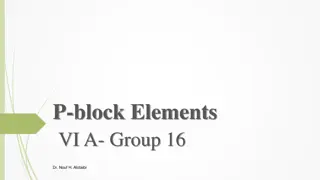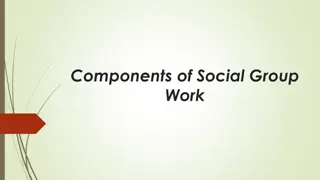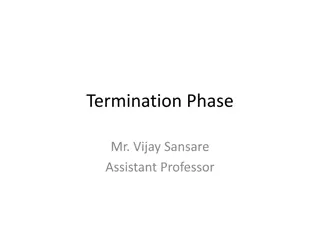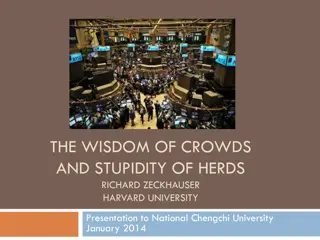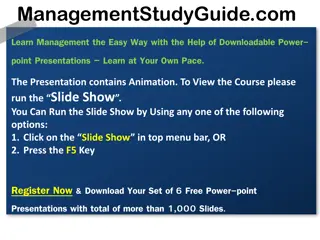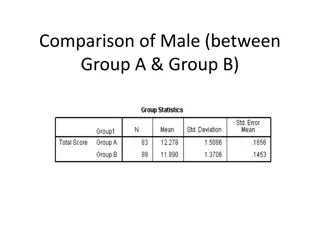Group
This content explores the concept of ionic bonding, electron configurations, and the octet rule. It discusses how atoms form ions by gaining or losing electrons to achieve stability. Examples of electron dot notation and crystal formation in ionic compounds are provided. Additionally, the properties of crystalline solids, such as high melting points and ionic conductivity, are explained.
Download Presentation

Please find below an Image/Link to download the presentation.
The content on the website is provided AS IS for your information and personal use only. It may not be sold, licensed, or shared on other websites without obtaining consent from the author.If you encounter any issues during the download, it is possible that the publisher has removed the file from their server.
You are allowed to download the files provided on this website for personal or commercial use, subject to the condition that they are used lawfully. All files are the property of their respective owners.
The content on the website is provided AS IS for your information and personal use only. It may not be sold, licensed, or shared on other websites without obtaining consent from the author.
E N D
Presentation Transcript
Group Group Valence Valence electrons electrons General electron configuration General electron configuration Example using dots for electrons Example using dots for electrons 1 1 2 2 13 3 14 4 15 5 16 6 17 18 7 8
Example: Rb loses one electron to form Rb+ Ca loses two electrons to form Ca2+ Al loses three electrons to form Al3+
Ionic Bonding electrical attraction between large numbers of cations and anions (metals & nonmetals); forms solid crystals Octet rule: Atoms tend to achieve a noble gas electron configuration when forming a chemical bond. (oct = 8; s & p orbitals add to 8; ns2p6) Use electron dots to predict the formulas for the compound formed between Li and Br Na and S see pg. 203 a) b)
1) Crystalline solids at room temperature *denoted by letter (c) ; 3D crystalline network; where each cation is surrounded by anions 2) HIGH MELTING POINTS! ex/ NaCl melts at 800 oC (1,474 oF) 3) Conduct electricity if dissolved in water (ions separate) & when in a molten state.
The chlorine atom gains seven electrons when it becomes an ion.
A) NaCl B) ClNa C) Na7Cl1 D) SCl
A) ZnN B) Zn2N C) Zn3N2 D) ZnN2 E) Zn2N3 F) ZnN3
A) Anions B) Cations C) Valence electrons D) Orbital electrons
A) Negative two B) Positive two C) IDK D) Positive one
A) None B) One C) Six D) eight
A cation is positively charged because it will gain electrons to have a stable electron configuration like a noble gas.
When an aluminum atom loses its valence electrons, what is the charge on the resulting ion? a. b. c. d. a. 2+ b. 3+ c. 2 d. 1+
The electron configuration of a fluoride ion, F , is a. b. c. d. ion. a. 1s22s22p5. b. the same as that of the neon atom. c. 1s22s22p63s1. d. the same as that of a potassium
A) Fe2O3 B) Fe2O2 C) FeO D) Fe3O2
An ionic compound is a. b. c. d. a. electrically neutral. b. composed of anions and cations. c. held together by ionic bonds d. all of the above
Which element when combined with chlorine would most likely form an ionic compound? a. b. c. d. a. lithium b. phosphorus c. oxygen d. bromine
A) Co3N2 B) Co(NO3)2 C) Co(NO3)3
Metallic bonding - between metal atoms; valence electrons are shared equally in a sea of electrons *This explains the properties of metals! The valence electrons are mobile and can drift freely from one part of the metal to another. Electrons are delocalized & gives metals Multidirectional strength (stretching & sheets)
When a metal slide past one another (hence malleable & ductile) metal is subjected to pressure, the metal cations easily Force Force Sea of electrons If an ionic crystal is struck with a hammer, the blow tends to push the positive ions close together. Nonmetal anion Metal cation Metal cation Strong repulsions The positive ions repel one another, and the crystal shatters (brittle). Metal Ionic crystal
Which of the following models can describe the valence electrons of metals? A. B. B. Octets of electrons C. D. A. A body-centered cube C. A rigid array of electrons D. A sea of electrons












